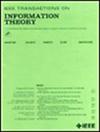估计熵和互信息的记忆复杂度
IF 2.2
3区 计算机科学
Q3 COMPUTER SCIENCE, INFORMATION SYSTEMS
引用次数: 0
摘要
我们观察到从未知分布p / $[n]$中提取的独立同分布随机变量$X_{1},X_{2},\ldots $的无限序列,我们的目标是在$\varepsilon $ -加性误差内估计熵$H(p)=-\mathop {\mathrm {\mathbb {E}}}\nolimits [\log p(X)]$。为此,在每个时间点,我们允许使用可能随机但定常的规则更新具有S个状态的有限状态机,其中为机器的每个状态分配一个熵估计。我们的目标是表征这个问题的最小存储器复杂度$S^{*}$,这是估计任务在p中至少以$1-\delta $渐近一致的概率可行的最小状态数。具体地说,我们表明存在通用常数$C_{1}$和$C_{2}$,使得$ S^{*} \leq C_{1}\cdot \frac {n (\log n)^{4}}{\varepsilon ^{2}\delta }$对于$\varepsilon $不太小,$S^{*} \geq C_{2} \cdot \max \left \{{{n, \frac {\log n}{\varepsilon }}}\right \}$对于$\varepsilon $不太大。用近似计数法估计p的对数,用有限记忆偏差估计机估计期望运算,证明了上界。通过对均匀性检验的熵估计化简,证明了其下界。我们还应用这些结果推导了互信息估计的记忆复杂度的边界。本文章由计算机程序翻译,如有差异,请以英文原文为准。
Memory Complexity of Estimating Entropy and Mutual Information
We observe an infinite sequence of independent identically distributed random variables $X_{1},X_{2},\ldots $ drawn from an unknown distribution p over $[n]$ , and our goal is to estimate the entropy $H(p)=-\mathop {\mathrm {\mathbb {E}}}\nolimits [\log p(X)]$ within an $\varepsilon $ -additive error. To that end, at each time point we are allowed to update a finite-state machine with S states, using a possibly randomized but time-invariant rule, where each state of the machine is assigned an entropy estimate. Our goal is to characterize the minimax memory complexity $S^{*}$ of this problem, which is the minimal number of states for which the estimation task is feasible with probability at least $1-\delta $ asymptotically, uniformly in p. Specifically, we show that there exist universal constants $C_{1}$ and $C_{2}$ such that $ S^{*} \leq C_{1}\cdot \frac {n (\log n)^{4}}{\varepsilon ^{2}\delta }$ for $\varepsilon $ not too small, and $S^{*} \geq C_{2} \cdot \max \left \{{{n, \frac {\log n}{\varepsilon }}}\right \}$ for $\varepsilon $ not too large. The upper bound is proved using approximate counting to estimate the logarithm of p, and a finite memory bias estimation machine to estimate the expectation operation. The lower bound is proved via a reduction of entropy estimation to uniformity testing. We also apply these results to derive bounds on the memory complexity of mutual information estimation.
求助全文
通过发布文献求助,成功后即可免费获取论文全文。
去求助
来源期刊

IEEE Transactions on Information Theory
工程技术-工程:电子与电气
CiteScore
5.70
自引率
20.00%
发文量
514
审稿时长
12 months
期刊介绍:
The IEEE Transactions on Information Theory is a journal that publishes theoretical and experimental papers concerned with the transmission, processing, and utilization of information. The boundaries of acceptable subject matter are intentionally not sharply delimited. Rather, it is hoped that as the focus of research activity changes, a flexible policy will permit this Transactions to follow suit. Current appropriate topics are best reflected by recent Tables of Contents; they are summarized in the titles of editorial areas that appear on the inside front cover.
 求助内容:
求助内容: 应助结果提醒方式:
应助结果提醒方式:


